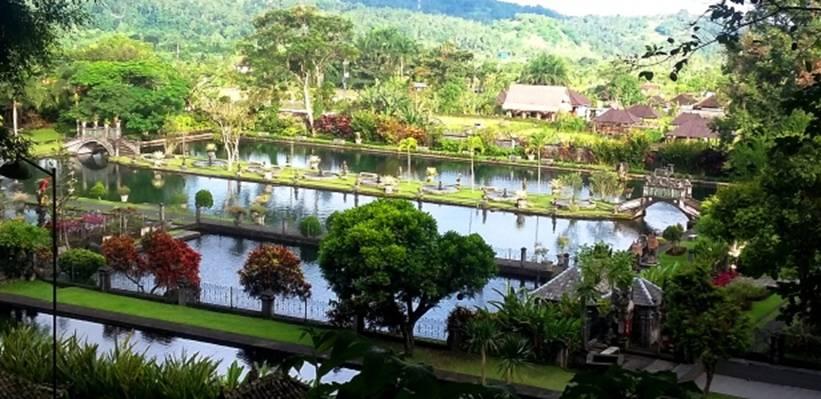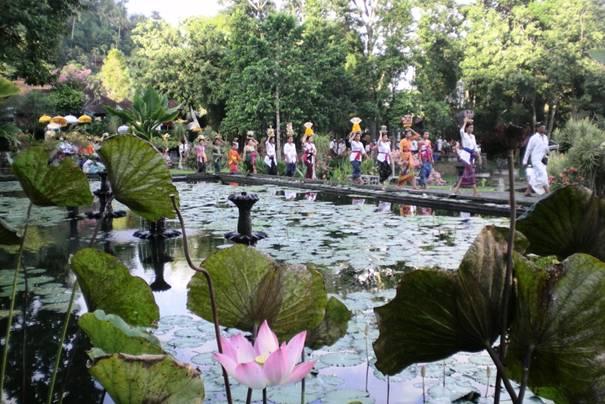Bali is an island in Indonesia and has largely native Hindu population. A water garden was built in Bali by Dr Anak Agung Made Djelantik in the year 1948 and named after the Hindu holy river Ganga.

Tirta Gangga – Bali
Tirta Gangga is a former royal palace in eastern Bali, Indonesia, about 5 kilometres from Karangasem, near Abang. It is noted for its water palace, owned by Karangasem Royal.
The primary draw in this area for visitors is the Tirta Gangga water palace, a lovely maze of pools and fountains surround by a lush garden and stone carvings and statues. The one hectare complex was built in 1946 by the late King of Karangsem but was destroyed almost entirely by the eruption of nearby Mount Agung in 1963. It has been lovingly re-built and restored and has an air of authentic royal magnificence. The centrepiece of the palace is an eleven tiered fountain, and there are many beautiful carvings and statues adorning the gardens.
Lempuyang Temple (Pura Lempuyang Luhur) is about 10 km east of Tirtagangga on the slopes of Mount Lempuyang. This is one of the key nine directional temples on the island. Park in the car park and walk up the steps to the temple. The lower temple is always open but the upper temple (at the top of the dragon staircases) is often locked, so it is best to go with a Balinese driver who will usually be able to arrange for the temple priest to open it up for you. It’s situated high up a mountain and there are magnificent sunset views at dusk.
Taman Ujung or Taman Sukasada (Sukasada Park) is 5 kilometers to the southeast of Karangasem (Amlapura), another water palace built by the predecessor of the King who constructed Tirta Gangga. It was largely destroyed by the eruption of Mount Agung in 1963, damaged again by an earthquake in 1979, and has not been restored on the same scale as Tirta Gangga.
Holy Water
The water from one of the natural springs of Tirtagangga has always been regarded as holy. It is used for religious ceremonies in the temples in the area until today. Tirta means blessed water, gangga came from Ganges, the holy river in India. The holy water is required for ceremonies of the temples in the surrounding as far as Tirtagangga can be reached by foot.

History
Dr. Anak Agung Made Djelantik (1919 – 2007) (source : http://www.tirtagangga.nl/)
After a childhood in the puri (palace) of Karangasem, my father was educated in Java and Holland. Completing his medical study during the turbulence 2nd world war, he worked from 1948 as a doctor and chief medical officer in various parts of Indonesia. From 1969 he was connected to the World Health Organisation, taking postings in Iraq, Somalia and Afghanistan. From 1979 he continued his passion for public health, culture and arts, especially painting, in Bali.
Construction (An account by Dr Anak’s son Widoere Djelantik)
In 1948 my grandfather built a watergarden complex which he gave the name Tirtagangga.
Apart from his personal interest, my grandfather built Tirtagangga for 2 main reasons:
– To ensure and improve the holiness of a holy place;
– To create a place of contemplation, rest and joy for every one, the local people as well as the domestic and foreign visitors.
These are still and will always be the purposes of the garden.
The religious function of the spring, the cool climate and the scenic beauty of the surrounding hills inspired him to build recreational water gardens for himself and his people. Making watergardens of all sorts had always been his hobby. He not only did all the designing himself, but he also used to work together with his labourers, digging in the ground, standing knee deep in the water, dirty with mud. It was always a great surprise for the visitors after some time looking at the work in progress to discover the tiny figure of the Raja among the workers. People liked it and it was one of his many charming traits.
The construction of the water gardens had been severe interrupted by the eruption of the Mount Agung which lasted from February to September, 1963. A series of eruptions occurred during those months. Lava and hot ash from the mountains had killed all vegetation. The grounds had not been affected by the lava flows which found their way along the valleys to the east and to the west of the complex. However, what had been built thus far was for the greater part destroyed by earthquakes of more and less severity during all those months. In addition to the natural disaster vandalism done by people who fled their villages and had no food had taken its heavy toll. The Raja family took refuge to saver place on the island. Tirtagangga was abandoned and fell pray to looting. Everything that could be taken away and sold such as furniture, windows, tiles, pipes, chinese porcelain, flower pots, statues and so on disappeared in the course of time.
When after about ten months the calamity was over the Raja returned, only to find the beautiful garden in ruins. There was no money for rebuilding the ponds and structures. With the introduction of the Land Reform Bill the Rajas, like all the other great land owners, had lost their means for extravagant undertakings. The rehabilitation of Tirtagangga could only be done in a very frugal and haphazard manner.
Since 1979, after a long duty period abroad, my father supervised the rehabilitation of the garden. With a slight increase of the entrance fees in 1985 a little bit could be accomplished. With the help of the local government the upper swimming pool was rehabilitated. Little by little the watergardens are coming into a better shape.
As my father became older, he was less capable in supervising the garden. In the nineties deterioration started again as very little maintenance was executed. During a walk in 1999, while overwhelmed by the majestic Banyan tree of the garden, I received a vision to transform the distressing state into the one of splendour. This vision was the reason why I found the foundation, drawn up the masterplan, build this website, seek for donation, incorporated the Balinese Hinduism-Buddhism concept in the complex, design the buildings, bridges, sculptures and so on to be able to restore the garden until the present shape.
WHO IS WHO
| Anak Agung Anglurah Ketut Karangasem (1887 – 1966) My grandfather, the last Raja of Karangasem, succeeded his uncle, Gusti Gede Djelantik in 1908 as stedehouder (local ruler under the Dutch colonisation). A born architect and lecturer, he build several watergardens and wrote many philosophical, ethical and religious notes, hymns and poems in the Indonesian and Balinese languages. As a child I found him most happy when sitting on his verandah or walking around enjoying the watergarden in a modest sarong, chewing his sirih. | |
| Dr. Anak Agung Made Djelantik (1919 – 2007) After a childhood in the puri (palace) of Karangasem, my father was educated in Java and Holland. Completing his medical study during the turbulence 2nd world war, he worked from 1948 as a doctor and chief medical officer in various parts of Indonesia. From 1969 he was connected to the World Health Organisation, taking postings in Iraq, Somalia and Afghanistan. From 1979 he continued his passion for public health, culture and arts, especially painting, in Bali. My father wrote several books, including an autobiography, The Birthmark (Periplus, 1997, isbn 9625931651). The autobiography is an excellent source to know more about the background of the watergarden. | |
| Widoere Djelantik (1953) My full name is Ir. Anak Agung Gede Dharma Widoere Djelantik MMIT. I spend most of my childhood in Denpasar, Bali. In 1971 I went to Holland, where I completed studies in architecture, fine arts and information technology. After posted abroad as development engineer in Mali, Botswana and the Maldives between 1979 and 1986, I worked as information analist for the municipal of Gouda until 1998. From then until today I am connected as senior adviser to Staatsbosbeheer, the Dutch forestry department. From childhood, the watergarden has always been an exciting place to me. With my sisters and other children I jumped in and out the water the whole day. In between the swims there were endless possibilities to play, such as building ships, daming the open gutters, playing in the rice fields or in the hills in the surrounding.
| |
| Agung Bagus (1971) Born and grown up outside Bali, my cousin Ir. Anak Agung Bagus Raka Barahyangwangsa obtained his master degree for architecture in Jakarta in 1995. Between 1979 and 1982 he lived in several south American countries, where his father served as ambassador for Indonesia. Before he and his family moved back to Amlapura in 2000, Agung Bagus has gained experience as architect and job captain in large projects such as Plaza Indonesia and Menara Jakarta. | |
| Surya Djelantik (1950) Like me, my sister Anak Agung Ayu Suryawati Djelantik spend most of her childhood in Denpasar, Bali. After completion of her hotel-management school in Holland in 1973, she worked at several Indonesian leading hotels, such as Kartika Plaza in Jakarta, Nusa Dua Beach and Sheraton Nusa Indah in Bali. |

